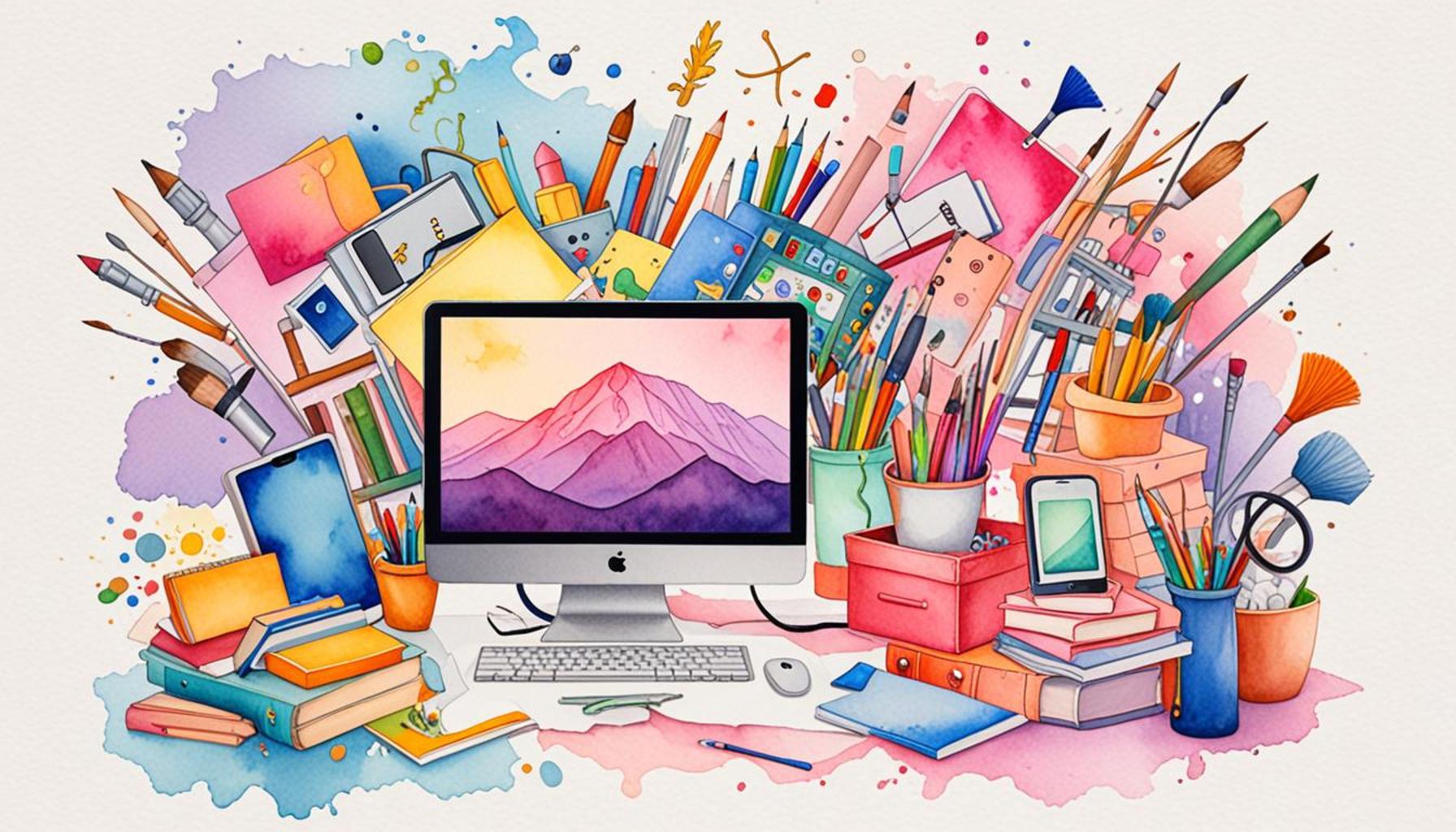The importance of digital decluttering: how to keep your online life organized and clutter-free.

Understanding Digital Clutter
In the age of information, each notification ping and email alert competes for our attention. This relentless barrage of digital inputs can quickly accumulate, creating a state of chaos that manifests as digital clutter. This chaos doesn’t just affect your desktop; it’s pervasive across all devices, from smartphones to tablets. A disorganized digital space disrupts workflows, leading to inefficiencies that can hinder both professional and personal endeavors.
The Extent of Digital Overload
The statistics paint a troubling picture of our relationship with technology. For instance, studies reveal that the average American spends over 5 hours a day engaging with their devices, which equates to nearly 1,825 hours annually. Imagine what could be achieved with that time if it weren’t lost in endless scrolling and searching through disheveled files.
Furthermore, research indicates that a cluttered digital environment can significantly contribute to increased stress and anxiety. The constant exposure to unorganized data can overwhelm the brain’s ability to process information effectively, leading to cognitive overload. A staggering 60% of adults report feeling swamped by the volume of information they must navigate online.
Why Digital Decluttering Matters
Understanding the implications of digital clutter is crucial, but the solutions are equally important. Enhanced productivity can be achieved when you adopt an organized approach. For instance, setting up folders labeled by project or topic can lead to quicker access to necessary documents, saving time and mental effort. When the digital workspace is streamlined, tasks can be completed more efficiently, allowing for a more productive use of that precious 5-hour daily window.
Moreover, fostering a tidy online environment can reduce stress significantly. A clear desktop or smartphone interface allows for a clearer mind, ultimately leading to greater focus and an ability to engage more deeply with one’s work. Imagine the difference it makes to work on a well-organized platform as opposed to a cluttered desktop filled with random screenshots and unused applications.

Additionally, let’s not overlook improved security. Removing unnecessary accounts, software, and files can protect sensitive data from potential breaches. In an era where data privacy is a rising concern, digital decluttering isn’t merely a matter of space; it’s a pivotal step in safeguarding personal information.
By embracing digital decluttering, we can create an online space that not only enhances our productivity but also supports our mental well-being. In the following sections, we will delve into practical strategies and tools that can help you manage and streamline your online life effectively. Get ready to reclaim your digital world!
DISCOVER MORE: Click here to learn about the impact of minimalism on mental health</p
Finding Your Digital Footprint
Before embarking on the journey of dismantling digital clutter, it’s essential to recognize the scale of the digital footprint we leave behind. This footprint is created through years of accumulated data, applications, emails, and countless subscriptions that often serve no real purpose. A typical American now possesses an average of 100 to 200 online accounts, each demanding its own username and password, contributing to chaos and potential security risks.
Many people think of decluttering solely in terms of physical spaces like closets or garages, yet digital organization is equally, if not more, vital in our increasingly virtual world. To effectively manage your online life, you must first comprehensively catalog what you own: files, emails, and applications. The sheer volume can be overwhelming, but taking stock is crucial. Consider where the most clutter accumulates:
- Email inboxes: A neglected inbox can become a digital landfill filled with promotions, notifications, and old messages.”
- Document storage: Files scattered across platforms like Google Drive, Dropbox, and OneDrive can lead to confusion and wasted time.
- Social media accounts: Overlapping connections, notifications, and posts can clutter your feed, diluting meaningful interactions.
- Applications and software: Apps that are no longer used still occupy storage space and potentially slow down devices.
The Ripple Effect of Digital Clutter
The impact of digital clutter extends far beyond mere inconvenience. The overload can cut into the cognitive resources needed for critical thinking and creativity. According to a study published in the *Journal of Consumer Research*, individuals who face a cluttered digital environment demonstrate a lower capacity for focused thought and creativity. This cognitive drain can severely limit problem-solving abilities needed in both personal and professional settings.
Moreover, digital clutter can lead to unintended consequences. For instance, important emails may be missed amidst the noise, or sensitive documents could be mistakenly deleted due to a disorganized filesystem. With cyber threats looming large, neglecting to manage your digital assets can also expose you to data breaches. The risk is heightened when sensitive information is scattered across multiple platforms.
As you start to recognize the extensive reach of digital clutter, keep in mind that addressing it is not merely about enhancing efficiency; it is about preserving your sanity and safeguarding your digital identity. Embracing structured organization can unveil significant benefits, enabling you to streamline tasks while enhancing overall productivity and focus. The road to a more serene online experience begins with understanding your digital landscape and taking the crucial first steps toward decluttering.
The Importance of Digital Decluttering
In today’s fast-paced digital world, many individuals find their online lives overwhelmed with excess information and unnecessary digital clutter. This disorganization not only hampers productivity but can also lead to increased stress levels. Taking the time to digital declutter allows one to create a streamlined online experience, making it easier to navigate daily tasks and responsibilities. Users can benefit from better focus, enhanced productivity, and a greater sense of control.
| Advantages | Details |
|---|---|
| Increased Productivity | With a clearer digital space, you can easily locate files and focus on important tasks without distractions. |
| Reduced Stress | An organized online environment contributes to a mental state that is more relaxed and less overwhelmed. |
Implementing regular doses of digital decluttering can transform how you interact with technology. Consider categorizing and deleting unused apps and files while also syncing your devices for better organization. This not only enhances your experience but also maintains essential digital security by reducing vulnerable data. To dive deeper into these methods, adopting a systematic approach can ensure long-term benefits to both your online life and overall well-being.
DIVE DEEPER: Click here to uncover the benefits of digital
Strategies for Effective Digital Decluttering
Once you have acknowledged the extent of your digital clutter, the next step is to implement strategies that will help you achieve a more organized and efficient online presence. With the right tactics, you can effectively streamline your digital life and enhance productivity.
1. Establish a Digital Decluttering Routine
Consistency is key when it comes to digital decluttering. Consider setting aside time each week or month to review your digital assets. During these sessions, you can categorize, archive, or delete files, emails, and applications you no longer need. This habit not only keeps your digital space tidy but also reiterates the importance of being mindful about your online resources. Creating a checklist—such as examining your inbox, reviewing social media connections, and evaluating applications—can serve as a practical guide during your decluttering sessions.
2. Utilize Organizational Tools
In this digital age, a variety of tools can assist in maintaining your online order. Document management software, such as Evernote or Notion, can help you organize your notes, file important documents, and track projects in an intuitive manner. For emails, tools like Unroll.me can efficiently manage subscriptions and declutter your inbox by consolidating newsletters into a single digest. Calendar apps can also be beneficial, allowing you to manage appointments and deadlines while reducing the chaos that arises from scattered information.
3. Implement the “One In, One Out” Rule
To prevent future clutter, adopt the “one in, one out” principle. This approach encourages you to remain mindful of what you are adding to your digital landscape. For example, if you download a new app, take a moment to uninstall one that is no longer in use. By consciously evaluating what enters your digital world, you maintain better control over your space, ensuring that it remains organized and functional.
4. Regularly Review and Resubscribe
Another key aspect of effective digital decluttering is periodically reviewing your subscriptions, particularly for newsletters and notifications that crowd your inbox. The average person receives about 121 emails per day, and a significant portion can be promotional or irrelevant. Taking the time to unsubscribe from unnecessary lists can clear up space, making it easier to track important communications while decreasing distractions. Platforms like Little Snitch can help keep tabs on background applications, revealing what is consuming your digital resources and bandwidth.
5. Prioritize Security Measures
In addition to enhancing organization, digital decluttering can reinforce your online security. Regularly updated passwords are paramount to protecting your accounts from cyber threats. Using password management tools like LastPass can provide a user-friendly way to store and manage login credentials securely. Moreover, enabling two-factor authentication adds an extra layer of protection to your most sensitive accounts. As you declutter, take the opportunity to eliminate old accounts that you no longer use, minimizing vulnerabilities associated with abandoned digital footprints.
By incorporating these strategies into your digital life, you not only find clarity among potential chaos but also position yourself to navigate your online world efficiently and securely. The focus on digital decluttering can transform how you interact with technology, turning it from a source of stress into a streamlined space that enhances your productivity and peace of mind.
DISCOVER MORE: Click here to unlock the secrets of a minimalist daily routine
Conclusion: Embracing a Clutter-Free Digital Life
In today’s fast-paced, technology-driven world, digital decluttering has become more than just an organizational strategy; it is essential for enhancing our overall productivity and well-being. As we’ve explored, the habitual accumulation of digital clutter—from overflowing inboxes to disorganized files—can lead to increased stress and inefficiency. However, by adopting practical methods and consistent routines, we can reclaim control over our online environments.
With tools designed to simplify our interactions with technology, the process becomes manageable. The implementation of the “one in, one out” rule, regular subscription reviews, and prioritizing security measures not only streamlines our digital spaces but also safeguards against potential threats. A clean and organized digital landscape fosters better focus, creativity, and time management, ultimately transforming how we engage with the technology that surrounds us.
Looking ahead, it’s important to recognize that the journey to a clutter-free online life is ongoing. As digital natives, we must commit to periodic evaluations and adjustments of our digital habits, ensuring that we adapt to new challenges and technologies. Engaging in continuous digital decluttering will serve as a proactive measure in maintaining an organized, productive, and enriching online experience. So, take the first step—declutter your digital life and witness how a more organized online presence can elevate both your personal and professional realms.


